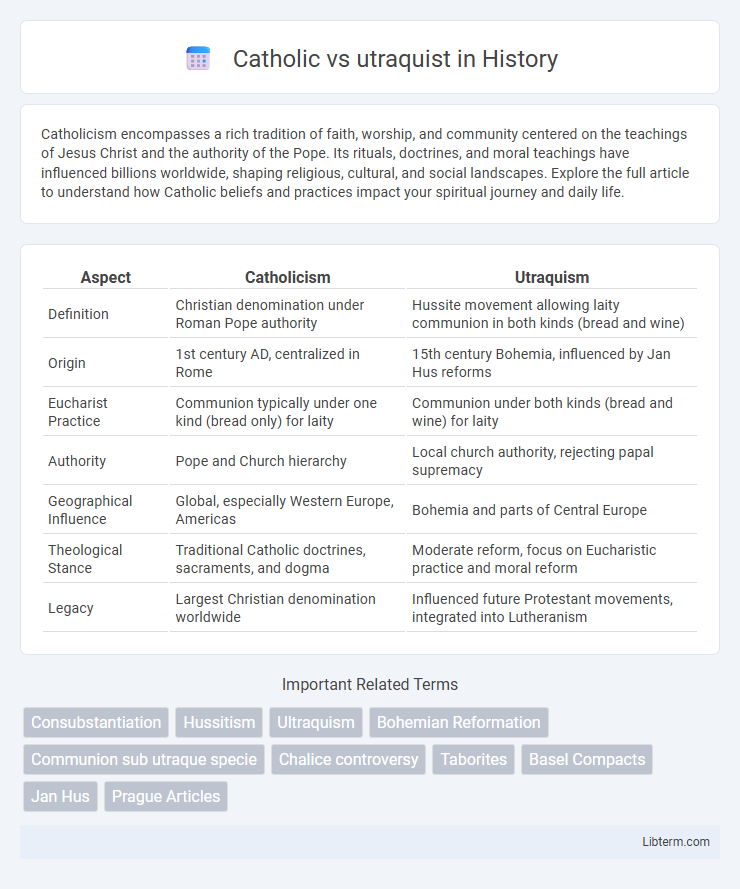Catholicism encompasses a rich tradition of faith, worship, and community centered on the teachings of Jesus Christ and the authority of the Pope. Its rituals, doctrines, and moral teachings have influenced billions worldwide, shaping religious, cultural, and social landscapes. Explore the full article to understand how Catholic beliefs and practices impact your spiritual journey and daily life.
Table of Comparison
| Aspect | Catholicism | Utraquism |
|---|---|---|
| Definition | Christian denomination under Roman Pope authority | Hussite movement allowing laity communion in both kinds (bread and wine) |
| Origin | 1st century AD, centralized in Rome | 15th century Bohemia, influenced by Jan Hus reforms |
| Eucharist Practice | Communion typically under one kind (bread only) for laity | Communion under both kinds (bread and wine) for laity |
| Authority | Pope and Church hierarchy | Local church authority, rejecting papal supremacy |
| Geographical Influence | Global, especially Western Europe, Americas | Bohemia and parts of Central Europe |
| Theological Stance | Traditional Catholic doctrines, sacraments, and dogma | Moderate reform, focus on Eucharistic practice and moral reform |
| Legacy | Largest Christian denomination worldwide | Influenced future Protestant movements, integrated into Lutheranism |
Overview: Catholicism and Utraquism Explained
Catholicism centers on the authority of the Pope and the belief in transubstantiation, where the bread and wine become the actual body and blood of Christ during the Eucharist. Utraquism, emerging from the Hussite movement in Bohemia, advocates for Communion under both kinds, meaning laity receive both bread and wine, contrasting with Catholic practice that often restricts wine to clergy. This theological distinction reflects broader calls for reform within Utraquism, emphasizing lay participation and scriptural accessibility.
Historical Context: Origins and Growth
The Catholic Church, established as the dominant Christian institution in Western Europe since the early Middle Ages, maintained centralized authority under the Pope in Rome. The Utraquist movement emerged in the 15th century Bohemian Reformation, advocating for receiving both the bread and wine during Communion, challenging the Catholic doctrine of offering only the bread to laity. This religious divergence grew amid the Hussite Wars and later influenced the Protestant Reformation, shaping the religious and political landscape of Central Europe.
Key Doctrinal Differences
Catholicism adheres to the doctrine of transubstantiation, believing the bread and wine become the actual body and blood of Christ, while Utraquists accept communion under both kinds (bread and wine) but reject transubstantiation, viewing Christ's presence as symbolic. The Catholic Church emphasizes papal authority and the seven sacraments as channels of grace, whereas Utraquists advocate for a more limited sacramental system and reject the pope's supremacy. Confession and purgatory are key Catholic doctrines opposed by Utraquists, who favor scripture as the primary authority over tradition.
The Eucharist Debate: One or Both Kinds?
The Catholic Church upholds the doctrine of communion under one kind for the laity, administering only the consecrated bread during the Eucharist to emphasize the fullness of Christ's presence. The Utraquists, emerging from the Hussite movement, insisted on communion under both kinds--bread and wine--for all believers, advocating this practice to promote lay participation and scriptural fidelity. This fundamental dispute over Eucharistic practice underscored broader theological and ecclesiastical conflicts during the Reformation era.
Church Authority and Leadership Structures
Catholic Church authority centers on the Pope as the supreme leader, with a hierarchical structure including cardinals, bishops, and priests emphasizing centralized governance. In contrast, Utraquist churches adopt a more decentralized leadership model, often allowing for greater lay participation and shared authority among clergy without a singular papal figure. This divergence reflects broader theological and ecclesiastical differences, impacting decision-making and church governance in both traditions.
Role in the Hussite Wars
The Catholic Church maintained its authority and sought to suppress the Hussite movement, aiming to restore orthodox Catholic dominance during the Hussite Wars (1419-1434). Utraquists, representing a moderate Hussite faction, demanded communion under both kinds (bread and wine) for laity, challenging Catholic sacramental practices and gaining significant support in Bohemia. The conflict embodied religious and political struggles, with Utraquists eventually achieving partial concessions that influenced the religious landscape of Central Europe.
Impact on Bohemian Society
The conflict between Catholics and Utraquists during the Bohemian Reformation significantly shaped social and political structures, fostering religious pluralism yet also causing deep divisions within Bohemian society. Utraquists, advocating for Communion under both kinds, promoted greater lay participation and challenged Catholic ecclesiastical authority, leading to increased tensions and eventual conflicts like the Hussite Wars. This religious contention influenced the cultural identity of Bohemia, contributing to its unique blend of religious practices and impacting governance through negotiated settlements such as the Compacts of Basel.
Relations with Other Christian Denominations
Catholic relations with Utraquists were marked by conflict and attempts at doctrinal reconciliation during the Hussite Wars and subsequent periods. The Utraquists, advocating communion under both kinds for laity, challenged Catholic Eucharistic practices, leading to disputes but occasional dialogues aimed at mutual understanding within Christianity. Despite tensions, both traditions contributed to shaping early modern Christian ecumenism and religious coexistence in Central Europe.
Decline and Legacy of Utraquism
The decline of Utraquism began in the late 16th century as the Catholic Church reasserted dominance through the Counter-Reformation and increased political support from Habsburg rulers. This diminished the Utraquist Church's influence, leading to its gradual absorption into Roman Catholicism by the 17th century. Despite its decline, Utraquism left a legacy of religious tolerance and contributed to the development of Bohemian Protestant traditions and liturgical reforms.
Lasting Influences in Modern Christianity
The Catholic Church's centralized hierarchy and sacramental traditions continue to shape global Christian practices, emphasizing papal authority and doctrinal continuity. Utraquism, emerging from the Hussite movement, influenced modern Protestant emphasis on communion under both kinds and lay participation, prefiguring some Reformation ideals. These lasting influences underscore divergent approaches to liturgy and church authority within contemporary Christianity.
Catholic Infographic

 libterm.com
libterm.com